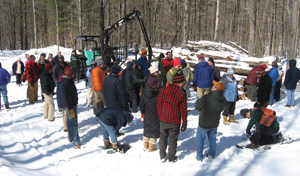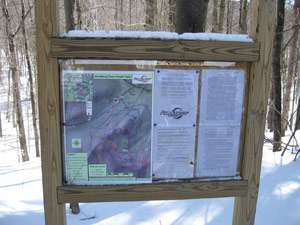A few Saturdays ago, I attended the third annual Vermont Town Forest Project summit. It was held in Hinesburg, Vermont, a town that lies about half in the rising, forested slopes of the Green Mountains and half in the flat, fertile Champlain Valley. Hinesburg’s fortunate to own not one but two town forests: the “older,” composed of 837 acres of mixed woodlands, and the “newer,” 301 acres boasting extensive wetlands and calcium-rich soils.
Hinesburg’s older town forest started as does a seed: in the spring of 1940, the town’s Selectboard asked Perry Merrill, Vermont’s first state forester, to designate 50 acres for a publicly owned woodland. Since then, the forest has grown dramatically, in both size and significance.
In fact, it’s a very model of town forest potential. It has recreation: the mountain-biking trails are so renowned that you can find a video of people riding them on YouTube. And skiing, hiking, horseback riding, etc. It also serves as an outdoor classroom, both for local teachers and for the University of Vermont, whose students have conducted dozens of projects there.
And it has active forest management: Chittenden County Forester Mike Snyder and logging contractor Rocky Martin took a group of us on a tour of the forest, where we saw Mike’s carefully planned marking and Rocky’s low-impact equipment and finished jobs. Mike showed us one small patch cut where Rocky had dropped trees marked for harvest. He pointed to a 10-foot-tall sapling smack in the center of the patch and said, “Do you see the nest in the top of that tree? That was there before Rocky took out the trees. That it’s still there now is the best example I can give to you of his skill.”
One of Rocky’s jobs was to harvest white ash, which was then milled and kiln-dried locally and installed to replace the floor of the Hinesburg Town Hall, which had been sanded so many times that the tongue of each tongue-and-groove board was exposed. All this at a total cost of $2.48 per square foot, about what you’d pay commercially. For this effort, the town was awarded the 2007 Tree Steward Award by Governor Douglas.
And it doesn’t stop there. The tireless work of the town forest committee, the Hinesburg Land Trust, the Trust for Public Land, the Vermont Land Trust, and the Vermont Town Forest Project has brought into existence the “newer” town forest, a project technically known as the LaPlatte Headwaters Conservation Initiative on Bissonette Farm. The partners had to act quickly and creatively to keep this land, some of the richest farmland in the area, out of the hands of developers. In the end, a combination of state riparian restoration funding, federal funding that resulted from a few lucky breaks (they just happened to find the endangered Indiana Bat on the property, and it also happened to have rare clayplain forest habitat), private donations, and limited, controlled development saved the parcel – a real treasure to the town and the state.
Talk about success story. The great thing is, Hinesburg’s only one of many Vermont communities with town forests. Some towns have had forests for years (the first enabling legislation for towns to acquire town forests was passed in 1915). Some towns are just acquiring them – a task made easier by the assistance provided by the Vermont Town Forest Project and by the program they, along with Senator Leahy, were able to stick in the 2007 Farm Bill: the Community Forest and Open Space Conservation Program, which will (if the Farm Bill’s ever passed) provide 50-50 matching grants for towns to acquire town forests.

The momentum’s building. Old town forests are being dusted off and looked at in a new light – as providers of essential ecosystem services, as outdoor classrooms, as places of solace and recreational pursuits, and as providers of locally sourced wood products. New town forests are popping up all over the place: take the Brushwood Community Forest in West Fairlee, which, thanks to the great work of Patricia Ayres Crawford (who is, incidentally, taking over Jad Daley’s responsibilities as coordinator of the Vermont Town Forest Project), has been designated top priority for federal Forest Legacy Program funding in Vermont.
In a way, the buzz over town forests in Vermont makes it seem like they’re the hot ticket, the greatest thing since sliced bread. And you know what? They kind of are. They’re reminders of a time when people in towns across New England shared farmland and forestland in common – collaborated on their stewardship, made decisions as a group, and reaped the rewards of all that work together. That kind of model doesn’t have to fade into the landscape like an old stone wall. It just needs a renewal – board for board, like an old town hall floor, replaced with thought and care, each board a piece of a tree that was just an eager seedling when the original floor was laid down. It’s time for us to plant the seeds that will become established town forests –sources of clean air and water, of habitat, of refuge, of livelihoods and necessary goods – for our grandchildren.
—Anne Margolis


